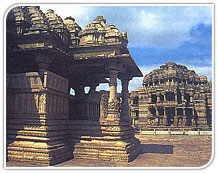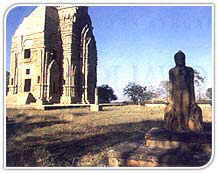 Teli
Ka Mandir and Sas Bahu Ka Mandir : The 9th century Teli Ka Mandir,
towering 100ft. high, is a Pratihara Vishnu temple of a unique blending of
architectural styles. The shape of the roof is distinctively Dravidian,
while the decorative embellishments have the typically Indo-Aryan
charactereistics of northern India. Also dedicated to Vishnu is the
graceful Sas-Bahu Ka Mandir built in the 11 th century.
Teli
Ka Mandir and Sas Bahu Ka Mandir : The 9th century Teli Ka Mandir,
towering 100ft. high, is a Pratihara Vishnu temple of a unique blending of
architectural styles. The shape of the roof is distinctively Dravidian,
while the decorative embellishments have the typically Indo-Aryan
charactereistics of northern India. Also dedicated to Vishnu is the
graceful Sas-Bahu Ka Mandir built in the 11 th century.
The
Fort : Standing on a steep mass of sandstone, Gwalior Fort dominates
the city and is its most magnificent monument. It has been the scene of
momentous events: imprisonments, battles and jauhars. A steep road winds
upwards to the fort, flanked by statues of the Jain tirthankaras, carved
into the rock face. The magnificent outer walls of the fort still stand,
two miles in length and 35 feet gigh, bearing witness to its reputation
for being one of the most invincible fort still stand, two miles in length
and 35 feet high, bearing witness to its reputation for being one of the
most invincible forts of India. This imposing structure inspired Emperor
Babur to desribe it as "the pearl amongst the fortrssess of Hind."
Madhya
Pradesh Tourism runs Sound and Light Show near Man Mandir in Hindi and
English every evening. Amitabh Bachchan, the Indian superstar, narrates
the story of Gwalior in his mesmerizing voice.
Gujari
Mahal : Within the fort are some marvels of medieval architecture. The
15th Century Gujari Mahal is a monument to the love of Raja Mashing Tomar
for his intrepid gujar queen, Mrignayani. The outer structure of gujari
Mahal has survived in an almost total state of preservation; the interior
has been converted into an Archaeoligical Museum housing rare antiquities,
some of them dating back to the Ist contury AD. Even though many of these
have been defaced by the iconoclastic Mughals, their perfection of form
has survived the ravages of time. Particularly worth seeing is the statue
of Shalbhanjika from Gyraspur, the tree goddess, epitome of perfection in
miniature. The statue is kept in the custody of the museum's curator, and
can be seen on request.
Man Mandir Palace : Built
between 1486 and 1517 by Raja Mansingh . The tiles that once adorned its
exterior have not once adorned its exterior have not survived, but at the
entrance, traces survived, but at the entrance, traces of these still
remain. Within, the palace rooms stand bare, stripped of their former
glory, testifying to the passing of the centuries. Vast chambers with fine
stone screens were once the music from the great masters of the day.
Below, circular dungeons housed the state prisoners of the Mughals.
Emperor Aurangzeb had his brother, Murad, imprisoned, and later executed
here. Close by is Jauhar Pond, where, in the Rajput tradition, the ranis
committed mass sati after their consorts had been defeated in battle. At
Man Mandir Palace, a poignant ambience of those day of chivalry and
heroism still lingers in the silent chambers. A superbly mounted
Son-et-Lumiere here brings it all alive every evening.
Suraj
Kund : Though major protions of the fort were built in the 15th
century, references to this gigantic complex can be traced back to 425
A.D. Older than the city is the Suraj Kund within the fort, walls, the
original pond where Suraj Sen, or Suraj Pal as he was later known, was
cured by saint Gwalipa.
 Gurudwara
Data Bandhi Chhod: Built in the momory of guru Hargobind Saheb, the
6th Sikh Guru who was imprisoned here by Emperor Jehangir for over two
years.
Gurudwara
Data Bandhi Chhod: Built in the momory of guru Hargobind Saheb, the
6th Sikh Guru who was imprisoned here by Emperor Jehangir for over two
years.
Jai vilas Palace and Museum : A splendour of a
different kind exists in the Jai Vilas Palace, current residence of the
Sciindia family. Some 35 rooms have been turned into the Jivaji Rao
Scindia Museum, and in these rooms, so evocative of a regal lifestyle, the
past comes alive. Jai Vilas is an Italianate structure which combines the
Tuscan and Corinthian architectural modes. The imposing Darbar hall has
two central chandeliers weighing a couple of tones and hung only after ten
elephants had tested the strength of the roof. Ceilings picked out in
gilt, heavy draperies and tapestries, fine Persian carpets and antique
furniture from France and Italy are features of these spacious rooms.
Eye-catching treasures include: a silver train with
cutglass wagons which served guests as it chugged around the table on
miniature rails; a glass cradle from Italy used for the baby Krishna each
Janmashtami, silver dinner services and swords that were once worn by
Aurangzed and Shah Jahan.
There are besides, personal mementoes
of past members of the Scindia family: the jeweled slippers that belonged
to Chinkoo Rani, four-poster beds, gifts from practically every country in
the world, hunting trophies and portraits. The Scindia Museum offers an
unparalleled glimpse into the rich culture and lifestyle of princely
India.
Tansen's Tomb : A pillar of Hindustani classical
music, the great Tansen, one of the nine jewels' of Akbar's court, lies
buried in Gwalior, the memorial to this great musician has a pristine
simplicity, and is built in the early Mughal architectural style. More
than a monument, the tomb is part of Gwalior's living cultural heritage:
it is the venue of a music festival on a national scale held annually in
November-December.
Ghaus Mohammed's Tomb : The sandstone
mausoleum of the Afghan prince, Ghaus Mohammed, is also designed on early
Mughal lines. Particularly exquisite are the screens which use the pierced
stone technique as delicate as lace.
Memorials: Ther
earliest freedom fighers, Tatya Tope and the indomitable Rani of Jhansi,
are commemorated in memorials in Gwalior. There are cenotaphs at major
public crossings, memorials of Scindia kinjgs and queens. Throughout the
city, there are these reminders of a pround past, of the great men and
womenof Gwalior who have their place in the nations's roll of honour.
Kala Vithika and Municipal Museum : The Kala Vithika is
another treasure house of the arts. It remains closed on Sundays and
public holidays. The Municipal corporation Museum, open all days except
Mondays, has a very fine natural history section.
Sarod
Ghar: this Museum of Music has been set up in the old ancestral house
of the legendary Ustad Hafiz Ali Khan. It houses ancient instruments of
the great Indian Masters of yesteryears. Sun Temple: Located near the
Residency at Morar, the newly constructed Sun Temple takes its inspiration
from the famous Konark sun Temple in Orissa.
Special
Offers on Hotels & Resort Booking in Gwalior
Travel
Agents & Tour Operators offering Travel Packages to Gwalior
Teli Ka Mandir and Sas Bahu Ka Mandir : The 9th century Teli Ka Mandir, towering 100ft. high, is a Pratihara Vishnu temple of a unique blending of architectural styles. The shape of the roof is distinctively Dravidian, while the decorative embellishments have the typically Indo-Aryan charactereistics of northern India. Also dedicated to Vishnu is the graceful Sas-Bahu Ka Mandir built in the 11 th century.
Gurudwara Data Bandhi Chhod: Built in the momory of guru Hargobind Saheb, the 6th Sikh Guru who was imprisoned here by Emperor Jehangir for over two years.